society is a type of harmonic ecological relationship among animals, which involves the organization of individuals of the same species, division of labor and cooperation between them. It is very common among insects but also happens to some degree in other groups such as mammals.
Characteristics of the Society
Society defines intraspecific and positive or harmonic relationships, as they occur between individuals of the same species, generating benefits for both parties. Among animals, social insects best exemplify this behavior; they are highly organized, divided into castes with complex functioning.
They exist evolutionary advantages in social behavior, generally these communities are very numerous (a hive can house between 5,000 and 100,000 workers and up to 400 drones) and their organization favors the maintenance and group protection. Also, share care for the offspring ensuring greater reproductive efficiency.
THE Communication is an important aspect in social insects, bees, for example, communicate through different sounds emitted with the movements of the wings. Termites carry out mouth-to-mouth communication (trophalaxis) through which they share food and spread pheromone.
bee society
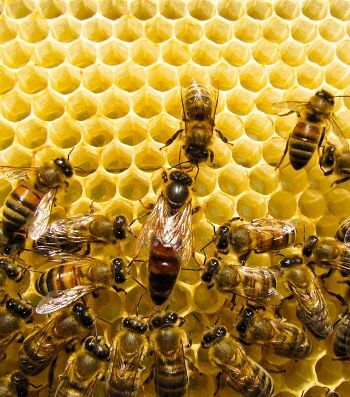 Queen bee surrounded by workers in the hive
Queen bee surrounded by workers in the hive
The bee castes are formed by the queen bee, workers and drones. Food is an important factor, as the differentiated diet determines the fertility of individuals, so all larvae can receive some Royal jelly, but only the Queens consume this food exclusively.
Queen Bee
The queen's function is reproductive, but also releases pheromones that help maintain social order, besides stimulating the drones when they are ready to be fertilized.
She is able to lay thousands of eggs a day and thus populate her colony. As there is usually only one queen in each group, she is the mother of all others.
Young queens not yet fertilized can dispute the place with the older one, giving her stings (unlike workers, queens do not die when using the stinger), but generally they go out and found a new hive.
They perform a bridal flight where they mate with several males and are able to store the different sperm for years, in a compartment called spermtheca. The larvae originating from the fertilized eggs will form workers or new queens, which varies according to the food they receive.
They can also reproduce asexually through a process called parthenogenesis, but it is occasional, only when they do not find drones to copulate.
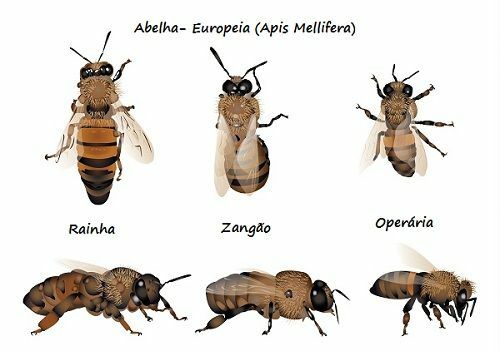 Illustration of caste representatives
Illustration of caste representatives
drones
They are the breeding males, they are generated by parthenogenesis from unfertilized eggs, therefore, they only have chromosomes originate from the mother and are haploid.
When the young queens perform the nuptial flight, the drones, which have a very keen sense of smell, recognize the females' scent and go to meet them to mate. They usually die soon after.
Also, despite not having a stinger, they have strong jaws that they can use to defend the hive from possible invaders.
worker bees
The workers work tirelessly for the maintenance of the hive. are sterile, cannot reproduce, but they are the ones who jointly take care of all the sisters that are generated by the queen bee.
are responsible for feed the larvae and all other members of the group. They breed larvae in special cavities. There, they are cared for and fed with royal jelly, which has essential nutrients for the development and subsequent sexual maturation of the queens.
Workers such as drones are fed honey and pollen, although their larvae may receive a small amount of royal jelly, which is the queen's exclusive food.
Read too:
- Insects
- social insects
- Pheromones
- Ecological Relations
Termite Society
Termites can live on the ground or in wood, where they make tunnels and galleries. They are organized into castes formed by the queen and the king, workers and soldiers. Unlike bees, each caste is made up of males and females.
 The queen with a developed abdomen, surrounded by workers and soldiers
The queen with a developed abdomen, surrounded by workers and soldiers
termites use pheromones to determine the differences of each caste, that is, each social category is defined by specific social hormones. They touch their jaws, passing food from mouth to mouth and along with pheromone droplets are transmitted.
This process of transmission of chemical messages, called trophalaxis, allows you to control the amount of each component inside the termite mound, but very little is known about this mechanism.
queens and kings
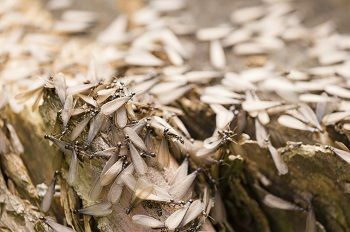 Winged forms of termites on wood
Winged forms of termites on wood
At the reproductive period (hot spring and summer months) males and females with wings make the nuptial flight and form couples. After mating, they lose their wings and build nests to reign together.
The queen has a very developed abdomen, because of the eggs she carries, making her much larger than other individuals. She is able to lay thousands of eggs, originating all the termites in the group. The king remains in the nest along with the queen.
Workers
Termite workers can be males or females and are sterile. Their function is to take care of the maintenance of the termite mound: they dig tunnels, collect food, take care of the offspring.
Soldiers
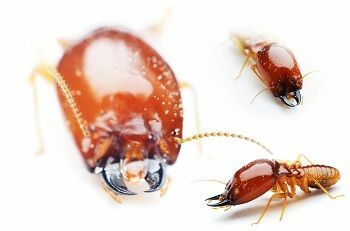 Detail of a soldier and his developed jaws
Detail of a soldier and his developed jaws
Termites are responsible for termite mound defense against invaders. They are sterile like the workers and have more developed jaw to drive out enemies.
society of ants
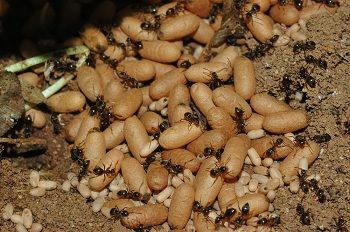 Workers take care of larvae and pupae
Workers take care of larvae and pupae
the varieties of ants are formed by queens, kings and workers. Similar to other social insects, the queen (or içá) and the king are fertile and responsible for reproduction, while the workers are sterile and take care of the maintenance of the anthill, they are the ones we see carrying leaves on one side to another.
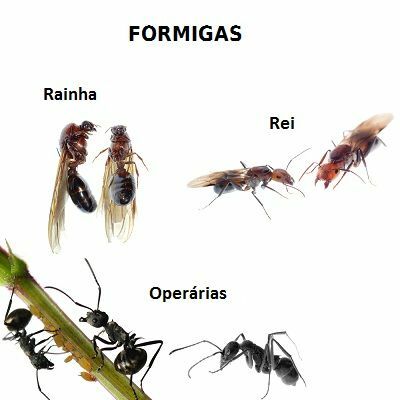 Castes of a kind of ant
Castes of a kind of ant
Queens and kings have wings, during the reproductive period they perform the nuptial flight, and after fertilizing the female develops the abdomen and lays thousands of eggs. The king dies shortly after mating.
The different species of ants feed in different ways, the saúvas, for example, cultivate fungi. They chew the collected leaves and make a cake on which the fungus will grow. When a new nest is created, the queen carries a small fungus ball with her to start the new creation and feed the group.
